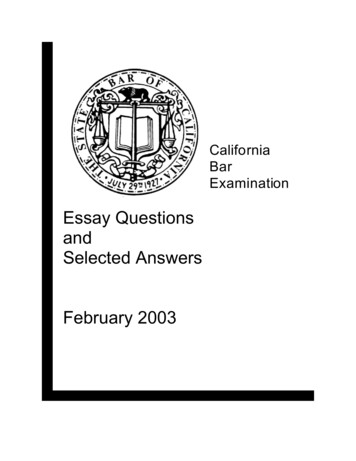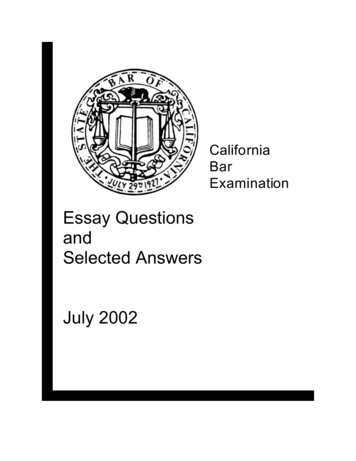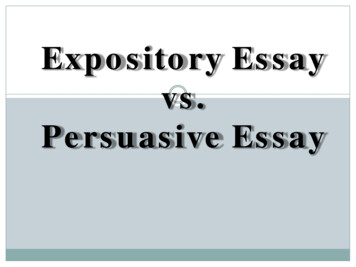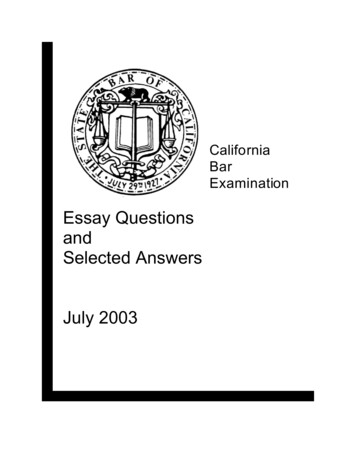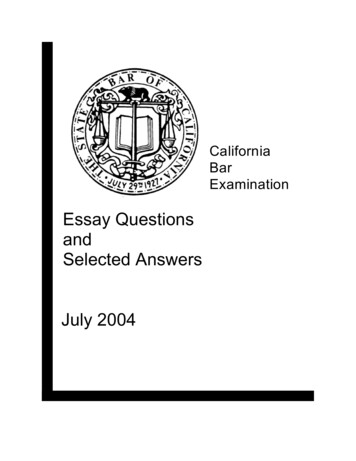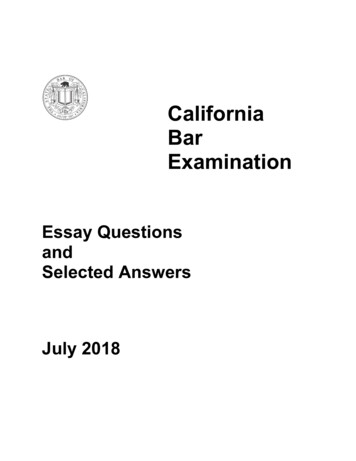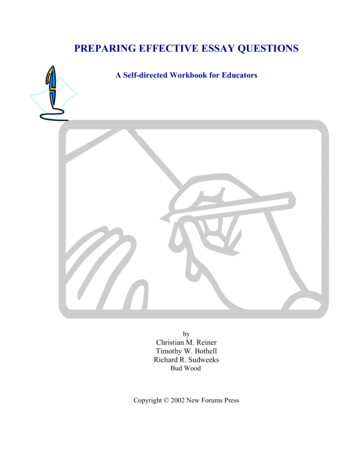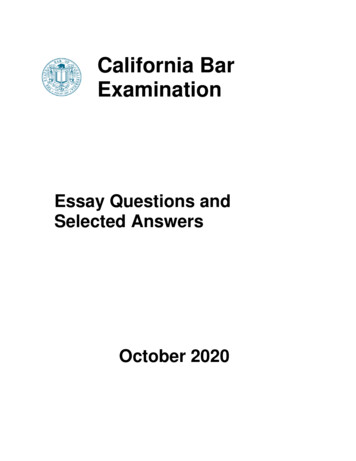
Transcription
California BarExaminationEssay Questions andSelected AnswersOctober 2020
COMMITTEE OF BAR EXAMINERSOFFICE OF ADMISSIONS180 Howard Street, San Francisco, CA 94105845 South Figueroa Street, Los Angeles, CA 90017415-538-2300213-765-1500ESSAY QUESTIONS AND SELECTED ANSWERSOCTOBER 2020CALIFORNIA BAR EXAMINATIONThis publication contains the five essay questions from the October 2020 California BarExamination and two selected answers for each question.The answers were assigned high grades and were written by applicants who passed theexamination after one read. The answers were produced as submitted by the applicant,except that minor corrections in spelling and punctuation were made for ease in reading.They are reproduced here with the consent of the authors.Question NumberSubject1.Professional Responsibility2.Business Associations3.Real Property4.Criminal Law and Procedure5.RemediesSan Francisco Office180 Howard StreetSan Francisco, CA 94105www.calbar.ca.govLos Angeles Office845 S. Figueroa StreetLos Angeles, CA 90017
ESSAY EXAMINATION INSTRUCTIONSYour answer should demonstrate your ability to analyze the facts in the question, to tellthe difference between material facts and immaterial facts, and to discern the points oflaw and fact upon which the case turns. Your answer should show that you know andunderstand the pertinent principles and theories of law, their qualifications andlimitations, and their relationships to each other.Your answer should evidence your ability to apply the law to the given facts and toreason in a logical, lawyer-like manner from the premises you adopt to a soundconclusion. Do not merely show that you remember legal principles. Instead, try todemonstrate your proficiency in using and applying them.If your answer contains only a statement of your conclusions, you will receive little or nocredit. State fully the reasons that support your conclusions, and discuss all pointsthoroughly.Your answer should be complete, but you should not volunteer information or discusslegal doctrines that are not pertinent to the solution of the problem.Unless a question expressly asks you to use California law, you should answeraccording to legal theories and principles of general application.
QUESTION 1Mary is a lawyer and represents Peg in a lawsuit alleging sexual harassment againstDoug. Doug’s lawyer is Len and the case is set for trial in Superior Court. Mary and Lendated and were intimate in the 1990s while in law school. They remain good friends, butare no longer romantically involved. Mary has not told Peg anything about herrelationship, past or present, with Len.Mary has determined that Doug will have to pay Peg damages after trial and that theprimary issue in the litigation is the amount of damages. Mary estimates that, at trial, acourt could award as little as 50,000 or as much as 150,000.Doug testified in a deposition a month ago that he had never been unfaithful to his wife.Peg confided to Mary that she has solid evidence confirming that, for the past year, Doughas been engaging in an extramarital sexual affair about which his wife is unaware. Peginstructed Mary to use the information about the affair as leverage in settlementdiscussions to get the maximum amount in damages.Mary agrees that, if she uses the fact of the affair in her negotiations with Len, the casewill likely settle for a larger amount to Peg than if she doesn’t mention the affair. Mary,however, strongly dislikes the idea of using that information. She is especiallyuncomfortable using this tactic in a case involving her good friend, Len.1. What ethical violations, if any, has Mary committed by not telling Peg about her pastand present relationship with Len? Discuss.2. Should Mary use the fact of Doug’s affair in settlement negotiations? Discuss.3. If Peg persists, can Mary ethically withdraw from representing Peg? Discuss.Answer according to California and ABA authorities.
QUESTION 1: SELECTED ANSWER AI. Mary's Past and Present Relationship with LenDuty of LoyaltyUnder both the ABA rules and the California rules, an attorney has a duty of loyalty toher client. This duty includes an obligation to avoid conflicts of interest between currentclients, current and former clients, clients and third parties, clients and the attorneyherself, and organizational conflicts when representing an entity such as a corporation.There are two duties relevant to Mary's past relationship with opposing counsel. First,an attorney cannot represent a client when one of her personal interests materiallyconflicts with an interest of the client in a way that could impair the attorney'srepresentation of the client. However, if the attorney reasonably believes -- that is,subjectively believes in an objectively reasonable way -- that she can diligently andcompetently represent the interests of the client, she can still represent the client aslong as she discloses the issue and receives informed consent. Under the ABA,informed consent may be oral and confirmed in writing, while under the California rulesthere must be written informed consent. Second, there is a specific duty with respect torelationships involving opposing counsel. If the attorney has a close personalrelationship with opposing counsel such as a familial relationship or close friendship, theattorney must disclose that potential conflict to the client. As with the general rule, inorder to press forward with the representation, the attorney must reasonably believethat she can adequately represent the interests of the client. Under the ABA, theattorney must receive informed consent, while under the California rules the attorney
must provide the client with a written disclosure of her relationship to opposing counsel.Here, Mary previously dated Len and was intimate with him during law school. She alsoconsiders him a "good friend." Under both the ABA and California rules, this arguablyqualifies as a close personal relationship with opposing counsel akin to a familiarrelationship or close friendship. As a result, out of an abundance of caution inattempting to comply with the "close relationship with opposing counsel" rule, Maryshould provide Peg with written disclosure of this potential conflict under the Californiarules and receive informed consent under the ABA rules. Further, even if her formerrelationship with Len does not constitute a close relationship with opposing counsel(say, because it is less close than a best friend or parent), Mary must still receiveinformed consent under the broader and more general personal interest rule. Under thebroader rule, she must receive informed consent confirmed in writing for the ABA rules,or informed written consent for the California rules.Another problem worth mentioning is that Mary may not be permitted to represent Pegin this matter whatsoever, as it appears she may not be able to competently anddiligently represent Peg. The problem states that Mary is deeply uncomfortable withmentioning Doug's affair even though this maneuver would likely lead to a bettersettlement award for her client. Specifically, it says she doesn't want to use this tacticagainst her good friend, Len. This suggests that even if Mary does believe that she canadequately represent Peg, that belief may be objectively unreasonable. Unless she isable to overcome her personal misgivings and zealously represent Peg, then Maryshould withdraw from the representation. Further, given that litigation is ongoing, Marywould need to seek approval from the court in order to withdraw from the
representation.II. Using Doug's Affair In Settlement NegotiationsCandor to the TribunalUnder both the ABA rules and the California rules, an attorney owes a duty of candor tothe tribunal. This means that an attorney may not knowingly offer false evidence andmust correct any material misstatements or misrepresentations on the record. While anattorney may offer evidence to the tribunal if they worry, but are not certain, that theevidence may be false, in general an attorney should strive to represent their clientswith candor and honesty to the court. That said, an attorney must balance this obligationagainst a duty to zealously represent the interests of their client within the ethicalbounds of the law.Here, it is possible that Peg's claim about the affair is true. It does not appear that Maryhas investigated the truth of this claim. This means that Mary does not know for certainthat the evidence is false, and she likely can offer the evidence to the tribunal withoutviolating her duty of candor to the tribunal. That said, some courts interpret the duty ofcandor to the tribunal to include properly investigating the factual basis for anyassertions. If so, Mary would need to look into the validity of Peg's assertion beforebringing it up in court in order to comply with her duty of candor to the tribunal.Duty of FairnessUnder both the ABA rules and the California rules, an attorney owes a duty of fairnessto opposing counsel. This means that the attorney may not suppress evidence she isrequired to disclose, and ought not to lie to opposing counsel or make dishonest
representations to opposing counsel with the goal of misleading opposing counsel.Here, as mentioned, there is no reason to think that Peg's discussion of Doug's affair isfalse. As a result, it would not violate the duty of fairness to bring up the affair duringsettlement negotiations. Thus, discussing the affair during settlement negotiations wouldnot violate the duty of fairness to opposing counsel (unless there is reason to think Pegis lying, or Mary investigates the claim and discovers it is false).Duty of HonestyUnder both the ABA rules and the California rules, an attorney owes a general duty ofhonesty to those they interact with in their role as an attorney. This means the attorneymust not make material misrepresentations or state falsehoods within the scope of theirrole as an attorney.Here, Mary needs to investigate the foundation of Peg's claim that Doug has had anaffair. Once she investigates the claim and determines whether it is certainly false ormay be true, she can rely on the evidence during settlement negotiations withoutviolating the duty of honesty. But if it turns out that Doug is not having an affair, thenMary could not rely on this assertion without violating the duty of honesty.Duty to Avoid Frivolous ClaimsUnder the ABA rules, an attorney ought not press a claim or argument unless there is agood faith basis in the law (or a good faith argument for extending or changing the law)in support of the claim or argument. In contrast, under the California rules an attorneymust not press a claim when she lacks probable cause for the claim and has a purposeof harassment for pressing the claim. Part of this duty is investigating claims to ensure
that they have a proper foundation under the law.As mentioned above, Mary needs to investigate the foundation of Peg's claim aboutDoug having an affair. If it turns out that the alleged affair is not real and Peg'sallegation is false, then pressing this claim in order to increase a potential settlementaward would be a frivolous claim or an argument without a good faith basis. That wouldviolate the ABA rules. It may also violate the California rules, if the court believes thatMary lacks probable cause (given that she did not investigate the claim or she did orthat she did and it turned out to be false or highly unlikely) and that she had a purposeof harassing opposing counsel in order to raise the settlement award. Thus, Mary needsto investigate the claim and ensure she has a good faith basis and probable cause tosupport bringing up the alleged affair during settlement negotiations.Duty of CompetenceUnder both the ABA rules and California rules, all attorneys have a duty of competenceto their clients. This includes having the relevant skills, knowledge, and preparation toadequately represent the client. In California, this also includes having the relevantmental and physical capacity, and an attorney must not recklessly, intentionally, grosslynegligent, or repeatedly violate this duty.Here, the idea that Mary must investigate Peg's claims goes in two directions. If shefails to investigate the claim, then she is not competently representing the client underthe ABA rules and she is arguably reckless or grossly negligent with regard to her dutyto investigate, and is thereby failing to adequately represent Peg under the Californiarules as well. On the other hand, if she investigates the claim and it does have a factualfoundation in the truth, then Mary would arguably be incompetent if she did not raise
this claim during settlement negotiations as she would be failing to zealously representthe interests of her client within the bounds of the ethical rules. Thus, Mary mustinvestigate Peg's claim and if it is true, she must press the claim in order to avoidviolating the duty of competence.Scope of RepresentationUnder both the ABA rules and California rules, an attorney must follow the bounds ofthe scope of representation. Some issues are solely up to the discretion of the client,including whether to accept a settlement offer, whether to testify, and whether to waivea jury trial right. The client also has full control over the goals and ends of therepresentation. However, the attorney has control over the means of representation,subject to a duty to consult with the client and communicate with the client about themeans of the representation.Here, whether to bring up the affair during settlement negotiations is arguably a "scopeof representation" issue that falls within the means of representation, much like whatquestions to ask during a deposition and what witnesses to call during a case. However,Mary must consult with Peg and must communicate with Peg about this strategic issue.Thus, in order to comply with her ethical duties, Mary must discuss and consult with Pegregarding this issue.Duty of CommunicationUnder both the ABA rules and the California rules, an attorney has a duty tocommunicate with the client. This includes keeping the client apprised of any
developments in the case, letting them know about written settlement offers or othermajor settlement offers, and generally consulting with the client and keeping in regularcontact.Here, Mary must communicate with Peg regarding whether to disclose the affair duringsettlement negotiations, as this is a strategy that she must discuss with Peg and consultwith Peg given her duty of communication.Duty Involving Leverage in a Civil CaseUnder the California rules, an attorney must not threaten criminal or disciplinary actionin order to obtain an advantage or leverage in a civil case. Here, if it is possible thatDoug's affair could subject him to disciplinary or criminal risk, then Mary must notleverage that risk in order to obtain a larger settlement award for Peg. On the otherhand, if the affair would not subject Doug to criminal or disciplinary risk, then Mary mustleverage these facts in order to fulfill her duty to zealously represent her client.Duty to "Tattle" On Opposing CounselUnder the ABA rules, if an attorney has actual knowledge that another attorney hasviolated the ethical rules or has taken some action that materially reflects poorly on theirfitness as an attorney, they must disclose these facts to the state bar association orother ethical authority. In contrast, the California rules do not have a similar provisionexcept that an attorney must disclose certain issues related to their own ethicalstanding. For example, an attorney must disclose if three or more malpractice suitshave been filed against them within one year, or if they have been convicted of fraud ora felony involving moral turpitude.
Here, Mary has not violated the California rule, but she may violate the ABA rule if shethinks that Len allowed his client to knowingly lie during his deposition testimony whenhe said that he had never been unfaithful to his wife. If Mary knows that Len was awareof Doug's affair, then she also knows that Len violated his duty of candor to the tribunaland his duty of fairness and honesty, and she must disclose that fact to comply with herduty to "snitch" or "tattle" on other attorneys.III. Withdrawal From RepresentationMandatory WithdrawalUnder the ABA and California rules, an attorney must withdraw from representation in afew circumstances. First, an attorney must withdraw from representation if their healthimpairs their ability to represent the client. Under the California rules, that impairmentmust make the representation "unreasonably difficult," while under the ABA rules it mustmaterially impair the attorney's ability to represent the client. Second, an attorney mustwithdraw from representation if the representation would necessarily lead to or facilitatea crime or fraud. Third, an attorney must withdraw from representation if therepresentation would violate an ethical rule (in California) or would violate an ethicalrule, a civil law, or a criminal law (under the ABA). Fourth, an attorney must withdraw ifthey are fired by the client. Finally, an attorney must withdraw if the client is asking themto press a frivolous claim, under the definitions provided above (e.g., probable causeand harassment in California, or lack of good faith under the ABA).Here, none of the mandatory bases for withdrawal have arisen as of yet unless Marycannot competently represent Peg given her prior relationship with Len, in which caseshe must withdraw from representation. Additionally, if Mary investigates Peg's claim
about the affair and it turns out to be false, but Peg insists on raising it during settlementnegotiations, then Mary must withdraw if continuing would lead to fraud. She must alsowithdraw if continuing would violate the duty to avoid frivolous claims, or any otherethical duty (under California rules) or ethical duty, criminal law, or civil law (under theABA rules). If any of those scenarios occur, then Mary must withdraw fromrepresentation.Permissive WithdrawalAdditionally, there are circumstances where an attorney may withdraw fromrepresentation permissively. These include when the client materially violates theretainer agreement and the attorney provides a warning that they will withdraw if theclient does not cease their violation, lesser forms of crime or fraud such as if the client isseeking to commit a crime or fraud in the future or if the client is trying to force theattorney to engage in a crime or fraud, if the attorney's health impairs the representationto a lesser degree, if there is good cause shown, if representing the client has becomeunreasonably difficult (including under the ABA if the client and attorney have afundamental disagreement), and for a variety of other reasons. Under the ABA, anattorney can withdraw for financial reasons or for any reason that won't materially harmthe client, and under the California rules an attorney can withdraw if they have a seriousdisagreement with co-counsel such that withdrawing is in the best interest of the client,or if the client wants to press an unwarranted claim or argument.Here, even if the mandatory withdrawal criteria outlined above are not met, Mary couldwithdraw from representation if she feels too morally conflicted about raising the affairduring settlement negotiations, assuming this is a fundamental disagreement (under the
ABA) or means that the client has made representation unreasonably difficult (Californiarules). She can also withdraw if she investigates the affair claim and believes it does nothave a strong basis in the truth and may therefore represent a crime or fraud. If she isso overwhelmed with her own guilt, she might also be able to withdraw permissively ifshe feels her personal mental health is so affected that her ability to represent Peg hasbeen impaired. She also might be able to withdraw from representation if the courtbelieves that a disagreement on this point with the client represents "good cause." Andunder the ABA, if she can show that withdrawal would not harm Peg, then she can alsopermissively withdraw on that basis alone.Steps After WithdrawalAfter withdrawing from representation, an attorney must take four steps under both theABA rules and the California rules. First, an attorney must return any unearned fees,although in California they may retain any true retainer fees or referral fees. Second, anattorney must return all of the client's personal property and papers, which they musthave carefully safeguarded in the meantime. Third, an attorney must mitigate anypotential harm to the client. Finally, an attorney must give the client proper notice and areasonable amount of time to find new counsel.Further, during ongoing litigation, an attorney must seek leave from the court beforewithdrawing. If the court denies the request, then the attorney must continue tozealously represent the client.Here, if Mary does withdraw from representation, then she must comply with theserequirements.
QUESTION 1: SELECTED ANSWER B1. Mary and Len's RelationshipDuty of loyalty--conflict of interest in accordance with both the ABA and CA rulesA lawyer owes their client an undivided duty of loyalty. This includes the duty to avoidconflicts of interest. A conflict of interest can be actual or potential, and arises when therepresentation is directly adverse to the interest of another client whom the lawyerrepresents in the same or substantially similar matter, or when there is a significant riskthat the representation will be materially limited by the lawyer's own personal interests,the interests of a former client, or a third person.Significant risk of material limitation--Mary and Len's Past relationshipHere, the case does not involve a situation where Mary is representing one who has aninterest directly adverse to another client of hers, but rather there is a situation wherethere could be a significant risk of material limitation in Mary's ability to represent Pegdue to Mary's own personal interests with having previously been romantically involvedwith Len.Because Mary could be inhibited by her prior romance with Len by not representing Pegwith the utmost loyalty, and because it could potentially cause issues with Mary's abilityto effectively represent Peg, Mary had a duty to disclose the conflict to Peg.Significant risk of material limitation--Mary and Len's current relationshipIn addition to the prior romance, there is also likely an actual conflict of interest here and
thus likely an actual significant risk of material limitation in her ability to represent Pegas the facts tell us that despite not being romantically involved anymore, Mary and Lenremain "good friends". The facts further evidence this later on by Mary's discomfort inusing the facts and tactic that Peg is suggesting (to be discussed further below) due tothe case involving her "good friend Len."Once again, because Mary's relationship with Len is likely impacting her ability tozealously represent Peg and causes her to not have her sole focus and attention onloyally and faithfully representing Peg, Mary had a duty to disclose the conflict to Peg.Waiving the conflict--ABA rules and CA rulesEven though a conflict persists, a lawyer still may be able to represent the client if theytake the proper measures in addressing the conflict and waiving it. The lawyer may onlycontinue the representation if: (1) they reasonably believe they can diligently andcompetently represent both clients; (2) the representation is not prohibited by law; (3)the claims do not involve a direct assertion by one client against the other; and (4) theclient gives informed consent, confirmed in writing. The California rules are the same,except that it requires both the disclosure and the consent to be in writing, as opposedto just 'confirmed' in writing like the ABA.Here, Mary may argue that she was able to diligently represent both clients since shewas still assessing the case, determining that Doug would have to pay Peg damagesafter trial, and that the primary issue was the amount to be given, and was makingestimates etc. Although, there is also a counter to this in the sense that Mary wasconsidering how Len would feel when considering tactics to use in settlementnegotiations (to be discussed more below.)
Although there are no facts that the representation is prohibited by law, regardless,Mary had a duty to disclose the actual and potential conflicts to Peg and to get herinformed consent, confirmed in writing (ABA) or to disclose in writing and get Peg'sconsent in writing. Mary failed to do this.ConclusionMary violated the ABA rules and committed an ethical violation when she did notdisclose her past and current relationship with Len and did not get Peg's informedconsent, confirmed in writing, to continue the representation.Mary violated the CA rules for not disclosing the same issues, as well as not disclosingin writing and getting Peg's consent in writing.California duty to disclose despite no significant risk of material limitationCalifornia has a specific rule that despite when there is no significant risk of materiallimitation in the representation, the lawyer still must disclose, in writing, to the client,when they or someone at their firm, has a personal, professional, financial or businessrelationship with another party or witness, or the lawyer of the other party or witness is afamily member, spouse, or lives with the lawyer, or the lawyer has an intimate or sexualrelationship with the other party or lawyer.Here, even if Mary wanted to argue that her past or current relationship with Len did notraise any significant risk of material limitation in her representation of Peg, under the CArules, because Mary has a past and current relationship with Len, this constitutes a'personal relationship' with the other party, specifically the other party's lawyer, and inaddition she had a prior intimate relationship with him.
Thus, regardless of what Mary felt about the risk, she still had a duty to disclose herrelationship with Len, in writing, to Peg.ConclusionBecause Mary did not disclose her relationship with Len in writing to Peg, shecommitted an ethical violation of the CA rules.2. Mary's use or non-use of the facts of Doug's affair in settlement negotiationsDuty of care/diligence in accordance with both ABA and CA rulesA lawyer has a duty to pursue a case with the care and diligence that one would bring totheir own personal matters. This includes the duty to: (1) research facts; (2) investigatematters; and (3) put in the time needed to present an adequate representation of theirclient's case.Here, Mary would have a duty to investigate the facts of the evidence that Peg ispresenting to her. Mary should not ignore what Peg is saying to her, as discussedbelow. Mary has a duty to pursue all legally available avenues in the representation,and because Mary has a duty not to present dishonest or frivolous or lies to opposingparties, Mary should look into what Peg is disclosing to her in order to make sure she isdoing her due diligence.Mary agrees that the fact of the affair would help Peg in settlement negotiations, andfurther, as discussed below, Doug alleged under oath that he has not been unfaithful tohis wife which goes directly to the claim of his sexual harassment of Peg because thatcould be construed as the same thing as him saying he did not sexually harass Peg.
Mary had a duty to research the facts that Peg is presenting to her and investigate it,and take the time needed to adequately prepare the case for Peg.ConclusionMary should take the care and diligence to pursue the use of the facts of the settlementnegotiations, and as long as she has no reason to believe it is something made up byPeg in order to just humiliate and embarrass Doug (something which would be inviolation of the professional rules), Mary should use the facts in settlement negotiations.Scope of representationA lawyer has a duty to pursue all legally available avenues in representing the client anddefending their case. The client has authority to decide whether or not to accept asettlement, whether or not to take a plea deal in a case, etc. The client controls theobjectives of the case, while the lawyer decides the tactics and the strategic moves ofthe case.Here, Peg is telling Mary that she has 'solid' evidence confirming that, for the past year,Doug has been engaging in an extramarital sexual affair about which is wife is unaware.The facts tell us that this is a claim about sexual harassment by Peg against Doug, andin addition, the facts tell us that Doug testified in a deposition (thus under oath) that hehas never been unfaithful to his wife. This statement by Doug goes directly to Peg'sallegation because if Doug had never been unfaithful, that means he would have neversexually harassed Peg. Thus, the fact regarding whether or not Doug has beenunfaithful to his wife is relevant. Mary has determined that Doug is going to owe Pegdamages, but it is just a matter of how much, and agrees that using the facts of theaffair in her negotiations with Len will likely result in a larger amount, which as the
lawyer for Peg, should be what Mary wants to pursue.Further, because the facts are actually relevant to the litigation, it would not be unethicalfor Mary to use the facts. Doug put it at issue by stating under oath he has not beenunfaithful to his wife. Although Mary has the authority to control the tactics for litigation,Peg as the client determines the objectives and the theory of the case and Mary shouldbe pursuing all legally available matters, and it is not a violation to use the facts.ConclusionMary should use the facts (subject to the above conclusion that she reasonably believesthere is some merit to them) since it is a legally available avenue that would help defendher client's case and provide her with the best results
San Francisco Office www.calbar.ca.gov 180 Howard Street San Francisco, CA 94105 . dated and were intimate in the 1990s while in law school. They remain good friends, but . long as she discloses the issue and receives informed consent. Under the ABA,
